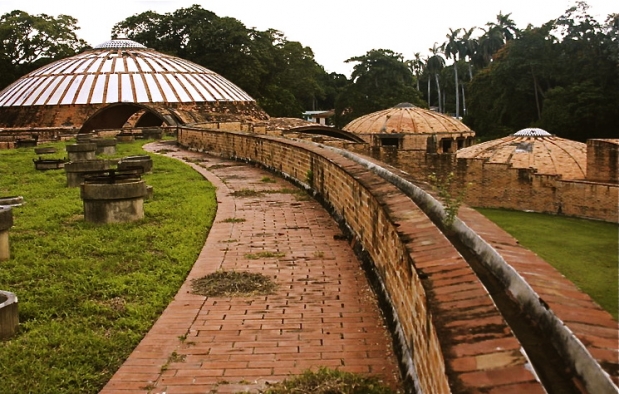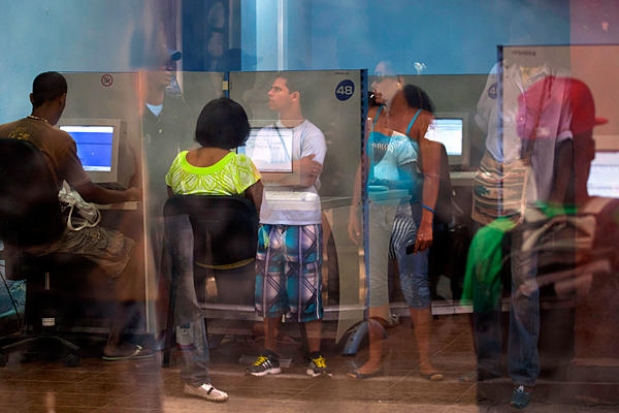
Six months ago I took an American photographer to meet to the former model and ex-ballerina Luz Maria Collazo. She had served as an interpreter with two other important Cuban ex-models and that would be our last evening of work. She was the main target of his lens and his interest, but when he saw that chance had led him also to the house of the architect Roberto Gottardi, he was surprised and pleased by the opportunity to meet and take a photo with him.
I had met Gottardi in 2020, when I interviewed Luz Maria Collazo. Until that time, her name and history at the National Art School was completely unknown to me. I suppose the same is true for many of my compatriots. She promised me an interview, but time passed and I was postponing that decision until I forgot about.
The reaction of the American photographer surprised me: Gottardo was an internationally well-known and respected architect. The school designed by him, along with Ricardo Porro and Vittrio Garatti, is considered one of the most representative works of Cuban architecture from the sixties.
The photographer knew about him from the documentary Unfinished Spaces by Alysa Nahmias and Benjamin Murray, which tells the story of the emergence of the idea of creating the National Art School, its design, construction and… its non-completion. That was how I learned of the existence of this film and a few days ago a friend made me a copy on a flash drive.
Unfinished Spaces shows us the National School of Art in the first half of the sixties, showing, almost from the beginning, images of the first moments after the victory of 1959: the real joy of the Cuban people in being liberated from the tyrant Fulgencio Batista; hope of the announced glorious future; the revolutionary ferment.
It was during this period that Fidel Castro and Ernesto Guevara appeared at the very exclusive Country Club, where they were not members, and while playing a round of golf, the leader had the idea of creating a school of art in that space. “We are going to build the best school of art in the world,” says the architect Selma Diaz, who was charged with leading the project.
The task of designing five faculties of art was assumed with overwhelming enthusiasm by architects Ricardo Porro, Vittrio Garatti and Roberto Gottardi; and not only by them, but also by the builders and the students who took classes within the site under construction and later participated voluntarily in the work to finish it, at the rhythm of small orchestras also composed of students. The actress Mirta Ibarra, a student at the school at the time, described the atmosphere as one of total freedom and creativity.
Very often, looking at those images of those early years of the Revolution, I wondered if, had I been a young woman at the time, would I have managed, or wanted to, hold myself apart from the effervescence. The music of Giancarlo Vulcano accompanying the images of Unfinished Spaces awakens a nostalgia for a past I didn’t experience and that in my eyes is like a legend, a fantastic epic, something unreal.
But amid the nostalgia an alarm sounds in my head: the leader of a country has the power to go to a private club, without invitation, and to decide to transform the space into something else?
Does being president mean being the owner of the country? In those moments I remember Fidel Castro was not then the president of Cuba. I see him playing golf with Ernesto Guevara and the image I see is consistent with the recent victory of his son Tony Castro in a golf tournament, and the courses that they built in this country to play this sport. I think that if gold was ever stigmatized as a “bourgeois sport” it was only in my imagination.
Half built, have destroyed
But Unfinished Spaces is not a documentary focused on criticizing the “Revolution” nor its maximum leader. The film puts its drama and music at the service of showing the history of this architectural masterpiece and its passage from a colossal project — the best art school in the world — to abandonment, neglect, “official marginalization” (the words of the architect Mario Coyula) and stigmatization of its creators.
Unfinished Spaces lets us hear the voices of those who were victims of unjust decisions that destroyed the school and with it an important project in the lives of these three artists; but it also shows the opposite view, that allows us to ask ourselves whether the construction of a school that size, with an unlimited budget, wasn’t a mistake, given the circumstances and resources of the country, although in practice the architects had decided to use the cheapest materials at your fingertips. There is also the testimony of the then students who witnessed the militarization and the expulsion of gay students.
Those who studied there then talk their way through the place that was turned into ruins before it was finished being built; the naturalness of one of them is striking when he says: “I think most students didn’t wondered why the school wasn’t finished, as there are many things in Cuba where the same thing happens.”
Buildings half built or half destroyed come to mind, building that never come to be repaired; the streets that are fixed and broken again in less than a month, the ruins visible from the buses. Are we living in an unfinished country, half built (or half destroyed)?
The National Art School has not only been the victim of wrong internal decisions, scarcities and looting by the homeless. The documentary doesn’t hide the fact that it could have been repaired and completed just a few years ago, but the regulations of the American “blockade” prevented it.
One of the questions I would have wanted to ask Gottardi is why he remained in Cuba, why was he the only one of the three architects who stayed. Now I won’t have to ask. His life, and also the lives of the other two artists abroad, have remained linked to the National Art School.
The shows the moment in which life rewards them, after 45 years, and it is just Fidel Castro, the first person to have a vision of that school, who decided the work should end. His confession of having fallen in love with the project when they showed it to him is surprising, but for a long time he reserved his opinion before the specialists who underestimated the work. His words are surprising because this is a man whose failure to listen to the specialist who warned him that it was impossible to produce ten million tons of sugar still devastates the country, nor did he listen to those who counseled against the planting of Caturra coffee or the closing of small businesses.
Anyway, the important thing is not the past, but rather resuming construction on the project. Porro’s two faculties were finished and only need to be restored. Those of Garatti and Gottardi need to be finished. Gottardo, however, realizes that his faculty is not going to be the same as it was going to be 45 years ago, the circumstances aren’t the same, the country is not the same. Nor could it be now what would have been more than 50 years ago, what was promised to our fathers.
Then, the end comes, not of the construction of the School, but of the documentary: due to the world economic crisis and the two hurricanes that hit the Island, the State stopped funding any unproductive architecture project, including the National Art School. It’s hard to know if we will see it brought to completion, and also whether this documentary will come to theaters in this country. But at least it is circulating from flash memory to flash memory, and to remain in this memory is bigger than our collective memory.
Yusimí Rodríguez López
From Diario de Cuba, 20 November 2013
Documentary by Alysa Nahmias and Benjamín Murray, 2011.

